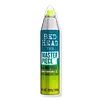What's inside
What's inside
 Concerns
Concerns

 Ingredients Side-by-side
Ingredients Side-by-side

Sd Alcohol 40
AstringentHydrofluorocarbon 152a
Octylacrylamide/Acrylates/Butylaminoethyl Methacrylate Copolymer
Aminomethyl Propanol
BufferingCyclopentasiloxane
EmollientCyclotetrasiloxane
EmollientPEG/PPG-17/18 Dimethicone
EmulsifyingTriethyl Citrate
MaskingParfum
MaskingBenzyl Salicylate
PerfumingButylphenyl Methylpropional
PerfumingCitronellol
PerfumingHydroxycitronellal
PerfumingLimonene
PerfumingLinalool
PerfumingPentaerythrityl Tetracaprylate/Tetracaprate
EmollientAmp-Isostearoyl Hydrolyzed Wheat Protein
CleansingPhenyl Trimethicone
Skin ConditioningEthylhexyl Methoxycinnamate
UV AbsorberSd Alcohol 40, Hydrofluorocarbon 152a, Octylacrylamide/Acrylates/Butylaminoethyl Methacrylate Copolymer, Aminomethyl Propanol, Cyclopentasiloxane, Cyclotetrasiloxane, PEG/PPG-17/18 Dimethicone, Triethyl Citrate, Parfum, Benzyl Salicylate, Butylphenyl Methylpropional, Citronellol, Hydroxycitronellal, Limonene, Linalool, Pentaerythrityl Tetracaprylate/Tetracaprate, Amp-Isostearoyl Hydrolyzed Wheat Protein, Phenyl Trimethicone, Ethylhexyl Methoxycinnamate
Alcohol Denat.
AntimicrobialDimethyl Ether
SolventOctylacrylamide/Acrylates/Butylaminoethyl Methacrylate Copolymer
Aminomethyl Propanol
BufferingParfum
MaskingPhenyl Trimethicone
Skin ConditioningPEG/PPG-17/18 Dimethicone
EmulsifyingTriethyl Citrate
MaskingT-Butyl Alcohol
PerfumingPentaerythrityl Tetracaprylate/Tetracaprate
EmollientEthylhexyl Methoxycinnamate
UV AbsorberWater
Skin ConditioningAmp-Isostearoyl Hydrolyzed Wheat Protein
CleansingDenatonium Benzoate
MaskingAlcohol Denat., Dimethyl Ether, Octylacrylamide/Acrylates/Butylaminoethyl Methacrylate Copolymer, Aminomethyl Propanol, Parfum, Phenyl Trimethicone, PEG/PPG-17/18 Dimethicone, Triethyl Citrate, T-Butyl Alcohol, Pentaerythrityl Tetracaprylate/Tetracaprate, Ethylhexyl Methoxycinnamate, Water, Amp-Isostearoyl Hydrolyzed Wheat Protein, Denatonium Benzoate
Ingredients Explained
These ingredients are found in both products.
Ingredients higher up in an ingredient list are typically present in a larger amount.
Aminomethyl Propanol is used to adjust the pH of products. It is also used as a base to create other organic compounds. Having a balanced pH is important for protecting your skin.
Aminomethyl propanol is safe to use in cosmetics up to 1%. It is soluble in water.
We don't have a description for Amp-Isostearoyl Hydrolyzed Wheat Protein yet.
Ethylhexyl Methoxycinnamate is an organic compound that provides UVB protection. It often goes by the more common name of octinoxate. It is created from methoxycinnamic acid and 2-ethylhexanol.
Ethylhexyl Methoxycinnamate absorbs UVB rays with wavelengths between 280-320 nm. UV absorbers protect your skin by using chemical reactions to convert UV rays into heat and energy.
UVB (290-320 nm) rays emit more energy than UVA rays. They are capable of damaging DNA, causing sunburns and are thought to be linked to skin cancer.
The state of Hawaii has banned sunscreens containing octinoxate due to its potential impact on coral reefs. More research is needed to bridge gaps in this research. The European Union allows higher levels of octinoxate in sunscreens than the US and Australia.
Ethylhexyl Methoxycinnamate is oil soluble. It is not stable and may lose efficacy when exposed to sunlight.
Learn more about Ethylhexyl MethoxycinnamateWe don't have a description for Octylacrylamide/Acrylates/Butylaminoethyl Methacrylate Copolymer yet.
Parfum is a catch-all term for an ingredient or more that is used to give a scent to products.
Also called "fragrance", this ingredient can be a blend of hundreds of chemicals or plant oils. This means every product with "fragrance" or "parfum" in the ingredients list is a different mixture.
For instance, Habanolide is a proprietary trade name for a specific aroma chemical. When used as a fragrance ingredient in cosmetics, most aroma chemicals fall under the broad labeling category of “FRAGRANCE” or “PARFUM” according to EU and US regulations.
The term 'parfum' or 'fragrance' is not regulated in many countries. In many cases, it is up to the brand to define this term.
For instance, many brands choose to label themselves as "fragrance-free" because they are not using synthetic fragrances. However, their products may still contain ingredients such as essential oils that are considered a fragrance by INCI standards.
One example is Calendula flower extract. Calendula is an essential oil that still imparts a scent or 'fragrance'.
Depending on the blend, the ingredients in the mixture can cause allergies and sensitivities on the skin. Some ingredients that are known EU allergens include linalool and citronellol.
Parfum can also be used to mask or cover an unpleasant scent.
The bottom line is: not all fragrances/parfum/ingredients are created equally. If you are worried about fragrances, we recommend taking a closer look at an ingredient. And of course, we always recommend speaking with a professional.
Learn more about ParfumPEG/PPG-17/18 Dimethicone is a type of silicone.
Pentaerythrityl Tetracaprylate/Tetracaprate is a mixture of pentaerythritol, caprylic and capric acid.
Phenyl Trimethicone is a silicon-based polymer. It is derived from silica.
Phenyl Trimethicone is used as an emollient and prevents products from foaming.
As an emollient, it helps trap moisture in the skin. It is considered an occlusive.
Learn more about Phenyl TrimethiconeTriethyl Citrate comes from citric acid. It has masking, perfuming, and solvent properties. As a solvent, this ingredient helps disperse ingredients evenly in skincare.
One manufacturer claims this ingredient can:
According to perfume manufacturers, this ingredient is almost odorless but has a mild fruity, wine and plum scent. It can be used to mask the scent of other ingredients.
This ingredient can be plant-sourced or synthetic; it can naturally be found in cabbage and white wine.
Learn more about Triethyl Citrate